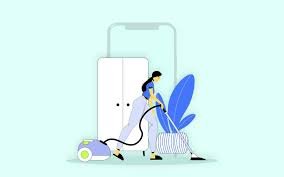The rise of on-demand services has transformed industries across the globe, and the cleaning sector is no exception. With busy schedules becoming the norm, consumers are increasingly turning to on-demand cleaning services for convenient, hassle-free cleaning solutions. Developing a house cleaning app or an on-demand cleaning app is a lucrative opportunity to tap into this growing market. In this guide, we’ll explore the key steps involved in building a successful on-demand cleaning service app, with insights into house cleaning app development, and how working with experienced developers like Cubes Infotech can ensure the app’s success.
Step 1: Identify the Core Features of Your On-Demand Cleaning App
Before diving into app development, it’s crucial to outline the core features your on-demand cleaning service app will offer. These features must cater to both users and service providers (cleaners) while offering a seamless experience. Here’s a breakdown of the key features:
User Features:
- User Registration & Profiles: Allow users to sign up easily through email, phone, or social media accounts. Profiles should store essential information like contact details, saved addresses, and payment methods.
- Service Selection & Booking: Users should be able to browse cleaning services, select the type of service they need (house cleaning, office cleaning, deep cleaning, etc.), and book appointments easily.
- Real-Time Scheduling: Provide users with the ability to book a cleaner instantly or schedule services in advance based on their preferred time and date.
- Payment Integration: Integrate secure and multiple payment gateways, allowing users to pay via credit card, digital wallets (Google Pay, Apple Pay), or in-app payments.
- Ratings & Reviews: Allow customers to review cleaning professionals and services after completion. This fosters trust and helps maintain service quality.
- Push Notifications: Keep users informed about booking confirmations, service reminders, and special promotions.
Cleaner Features:
- Cleaner Profiles & Availability: Cleaners should be able to create detailed profiles, list their services, set their availability, and manage their bookings.
- Job Listings & Acceptance: Cleaners should receive job requests in real time, with the option to accept or decline based on their schedule.
- In-App Navigation: Cleaners should have access to GPS navigation to easily find the client’s location.
By identifying and integrating these features, you’ll ensure a smooth experience for both users and cleaning professionals.
Step 2: Choose the Right Technology Stack for Your App
Building a robust on-demand cleaning app requires a solid technical foundation. Choosing the right technology stack is vital to the app’s performance, security, and scalability. Depending on your target audience, you’ll need to develop the app for both iOS and Android platforms. Here’s a common tech stack for house cleaning app development:
- Frontend Development:
- iOS: Swift
- Android: Kotlin or Java
- Cross-Platform: React Native, Flutter (for building a single app for both platforms)
- Backend Development:
- Programming Language: Node.js, Python, or Ruby
- Framework: Express.js (for Node.js), Django (for Python), or Ruby on Rails
- Database: MySQL, PostgreSQL, or MongoDB
- Payment Integration: Stripe, PayPal, Braintree
- Cloud Storage: Amazon Web Services (AWS), Google Cloud, Microsoft Azure
The experienced team at Cubes Infotech can help you choose the right technology stack based on your specific requirements, ensuring that your app is both scalable and secure.
Step 3: Design the App’s User Interface (UI)
A clean, intuitive, and user-friendly interface is essential for retaining users. The design of your on-demand cleaning app should be simple, yet functional, and should offer a seamless experience from start to finish.
Key UI Design Elements:
- Minimalist Design: Keep the interface simple and clutter-free. Users should be able to book cleaning services in just a few clicks.
- Easy Navigation: Use clear buttons, icons, and visual cues that guide the user through the app without confusion.
- Brand Consistency: Ensure that the design reflects your brand, using consistent color schemes, fonts, and logos.
By working with professional UI/UX designers, such as the experts at Cubes Infotech, you can create an engaging and intuitive design that resonates with your target audience.
Step 4: Develop the App’s Backend and APIs
Once the design and front-end of the app are set, the next step is to develop the backend—the engine that powers your app. The backend is responsible for managing data, connecting users with cleaners, handling payments, and storing essential information.
Key Considerations for Backend Development:
- Real-Time Communication: Use WebSocket or similar protocols to enable real-time communication between users and cleaning professionals. This allows for instant notifications, updates, and communication.
- Data Security: Ensure that all user and payment information is encrypted and stored securely. Comply with GDPR and other data protection regulations.
- APIs Integration: Implement third-party APIs for essential functions like location tracking (Google Maps API), payments (Stripe, PayPal API), and SMS notifications (Twilio).
Cubes Infotech specializes in backend development, ensuring your app is secure, fast, and capable of handling large volumes of data and transactions.
Step 5: Test and Launch the App
Testing is a crucial phase of app development, as it helps identify and resolve any bugs or issues before the official launch. Thorough testing ensures that the app works smoothly across different devices, screen sizes, and operating systems.
Key Testing Methods:
- Functional Testing: Ensure that all features, from booking to payments, work seamlessly.
- Usability Testing: Test the app’s usability with a sample group of users to gather feedback on the interface and functionality.
- Security Testing: Verify that sensitive information, like payment details and personal data, is protected from breaches.
Once testing is complete, you can proceed with launching the app on both Google Play Store and Apple App Store. To maximize visibility, use SEO-friendly descriptions and keywords to help potential users find your app.
Step 6: Marketing and Promotion of Your App
Building a high-quality on-demand cleaning service app is just the first step. Promoting it effectively will help you attract customers and build a loyal user base. Utilize various marketing strategies to reach your target audience, including:
- Social Media Marketing: Leverage platforms like Instagram, Facebook, and Twitter to engage potential customers with content showcasing your cleaning services.
- Referral Programs: Offer discounts or rewards to users who refer your app to their friends and family.
- Email Campaigns: Send out newsletters and promotional offers to both new and existing users to drive repeat bookings.



